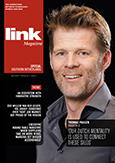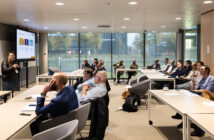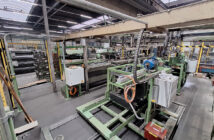Inkjet printing is well-known from the graphics industry, but it also lends itself to industrial applications, from solar to semicon to display. Thanks to Dutch expertise in high-tech integration and the presence of a complete supply chain, Meyer Burger Netherlands has grown into a leading equipment manufacturer for so-called functional inkjet printing. With a portfolio that includes R&D, pilot and production printers, the company is now ready for the industrial breakthrough of this production technology. ‘I’m still amazed by the big names that want to work with us.’
Fertile ground for functional inkjet printing
It started with the Eindhoven-based OTB (‘Only The Best’), which built machines for solar cell production using PECVD (plasma-enhanced chemical vapour deposition). OTB also developed machines for other material deposition technologies, including inkjet printing. Although this technology is also suitable for producing solar cells, it has a much broader application range. This placed the company – currently a member of the Roth & Rau Group – squarely on the radar of the Swiss Meyer Burger, which had made it big in the volatile solar industry and was looking for opportunities to expand and diversify its market footprint. With around eighty employees, the Eindhoven branch of Meyer Burger (over 1200 employees) is an independent unit that develops and builds PECVD machines and inkjet printers. About fifteen years ago, it introduced a system for R&D applications that would enable customers to develop their own applications. A pilot printer for process development and pilot production was later added to the range and in 2013 Meyer Burger introduced the JETx platform for reliable and cost-effective volume production. All printers are marketed under the brand name PiXDRO.

Marketing & Business Development Manager Erik Corduwener
Broad
Meyer Burger’s broad portfolio, from R&D to production machine, and the broad range of applications that the printers that can accommodate are what set Meyer Burger apart from its peers, according to Marketing & Business Development Manager Erik Corduwener. In addition to solar (deposition of an anti-reflection layer), inkjet printing also offers interesting options for the semiconductor industry, such as the direct application of mask, material or protective layers, or the packaging of components. Inkjet printing is also gaining ground in the electronics industry, for example for the application of solder masks on printed circuit boards (PCBs). For the display market, pixel printing is used for large OLED TV screens. Meyer Burger’s key competition is not so much fellow printer manufacturers as alternative production technologies, such as photolithography, dispensing, spray coating and screen printing. ‘Inkjet printing is a disruptive technology for such established processes. Using direct inkjet patterning rather than the conventional patterning process (where a resist layer is deposited, exposed and developed to form a pattern), for example, offers cost and flexibility benefits.’
The PiXDRO machines can print a broad range of materials, from chemical etching masks to a variety of electrically-conductive inks or insulating polymers. They can do this on various substrates: wafers, lead frames, PCBs, glass and even roll-to-roll plastics. Meyer Burger also serves a very diverse customer base: automotive, aerospace, electronics assembly companies, manufacturers of consumer electronics and display makers. ‘The focus in America and Europe is on engineering, while in Asia it’s more on mass production. What is greatly rewarding for us is when customers in America or Europe develop their applications on our R&D or pilot machines and then transfer the volume production to Asia. It doesn’t necessarily have to be on our production machines, although it obviously facilitates the scale-up.’ Wouter Brok, Innovations Manager: ‘I’m still amazed by the big names that want to work with us. These big companies have been showing interest in inkjet printing for four or five years now. It usually involves a long upfront process, where we help customers to qualify their printed products; entry into the automotive or medical market, for example, is a lengthy process.’
Momentum
The smallest droplets produced by a printer have the volume of a picolitre (one millionth of a millionth of a litre); that corresponds to a droplet diameter of two-hundredth of a millimetre. If smaller than that, they have – in physics terms – insufficient momentum; they just blow away. Commercially, inkjet printing has gained ample momentum, according to Corduwener: ‘We now see a transition from R&D to production.’ For which Meyer Burger offers its flexible, modular JETx platform. This machine is easy to configure for customer applications and desired level of automation (e.g. handling with a specific substrate holder in an inline or batch process). It is also important that large material manufacturers, such as SunChemical, DowDuPont, Evonik and Agfa, develop special formulations for inkjet, says Brok. ‘Together with our customers, we can push material suppliers to do so.’
But, obviously, printheads are also required. ‘We don’t make it ourselves; that is an expertise in itself. The manufacturers for the graphics world, such as Fujifilm Dimatix, Xaar and Konica Minolta, already make printheads for industrial applications. In the case of corrosive inks, for example, they apply – in consultation with us – an extra coating on the interior of their heads. These heads are an important component of our machines, but they are not at the core of the printing process. To make a functional structure, you need to do much so more than just push ink out of the head. It also has to do with how the ink droplets interact with the substrate; the way in which you allow layers to build up, spread and dry, and the timing and accuracy with which all of this happens. We have the knowledge for this and it is incorporated in the printing strategies and algorithms that control our machines. There were companies that thought they only needed to buy a printhead and an xyz stage (for aligning the printhead with the substrate) and connect them together; but they had to seek us out again later; things hadn’t turned out to be quite as simple as they’d thought.’ Meyer Burger also purchases many components and modules for its machines, says Corduwener. ‘Thanks to the history of the Philips group, which lives on in Philips Healthcare, ASML and FEI, among others, the Eindhoven region offers a great infrastructure for outsourcing.’ Brok: ‘Our expertise lies in integrating all of that: process and material knowledge, printhead, stage, automation and also the software – controlling the printheads requires continuous delivery of a significant amount of data.’
Scalable
Meyer Burger participates in application-oriented research projects at institutes all over the world. A development driver for printheads is not only the reduction of droplets (and thus improvement of the print resolution), but also the increase in the number of nozzles per printhead and the printing frequency (more droplets per second). All this serves to increase the productivity for industrial applications. Brok: ‘An important advantage of inkjet printing is scalability: you can easily install several heads in a machine. If they all print the same material, you increase productivity, but if the materials are different, you will gain more flexibility.’ All of this contributes to the fact that inkjet printing is now on the verge of an industrial breakthrough, says Corduwener. ‘Thanks to our outsourcing model and a flexible supply chain, Meyer Burger is prepared for this.’ Speaking of scalability.






